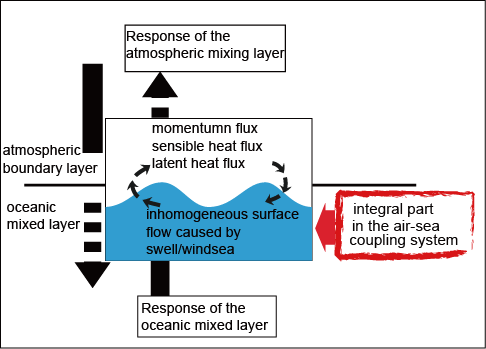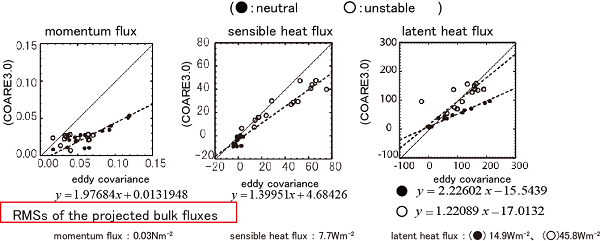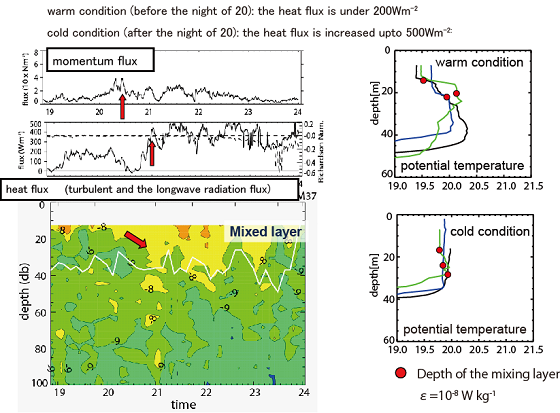Study of the impacts of wind waves and energy dissipation on air-sea momentum exchange
| A02-K5. Study of the impacts of wind waves and energy dissipation on air-sea momentum exchange | |
|---|---|
| PI | Masanori KONDA* (Assistant Professor, Kyoto University) |
[Doctral degree: *Oceanography]
Recently, the importance of the role of the air-sea interaction on the mid-latitude climate variability is being emphasized. Especially, the Kuroshio and the Kuroshio Extension region, which are one of the strongest frontal region of the sea surface temperature (SST), releases the large amount of heat from the ocean to the atmosphere in the fall-winter season. However, the former studies did not necessarily show the quantitative evidence of the impact of the air-sea energy exchange there, as they were likely to employ the leading mode analysis such as the empirical orthogonal function.
From this point of view, we will aim to understand the physical process of the air-sea boundary layer variability, the surface energy exchange, and the ocean mixed layer variation, as well as their relationship from observational facts.
These observational results will provide important information to connect variations of the individual boundary layers of the ocean and the atmosphere (Fig. 1). We will make an approach investigating elementary processes at the interface between the ocean and the atmosphere through these observations for the further goal to elucidate the role of the air-sea interaction in the Kuroshio Extension region to the mid latitude climate.
We, as the first approach, will carry out ship observations of the ocean-atmosphere coupling system, which consisted of the accurate air-sea fluxes and the ocean turbulence, aiming
1. improvement of the shipboard measurement of the eddy covariance flux
on the basis of the comparison between the eddy-covariance flux and
the bulk flux,
2. the bulk flux is to be retrieved with correction fitting the eddy covariance flux,
3. the turbulent energy budget on the basis of the quantitative analysis of the surface energy exchange and the dissipation rate of the ocean surface,
4. the influence of ocean waves (swells and wind waves) on the air-sea turbulent energy exchange.
- (i) We will obtain turbulent fluxes between the air and the ocean on the ship by the direct measurement of the eddy covariance of the boundary layer parameters (an eddy covariance system developed by Okayama University). At first, we will analyze the data obtained by a preliminary measurement, which we have already done in October 2009 to the north of the Kuroshio Extension. The direct measurement of the turbulent heat fluxes on the moving platform is known to have a space for improvement. After the improvement, the bulk scheme, which is widely used to estimate turbulent heat flux for the sake of the easiness and the simplicity, will be validated. We expect that we can modify or add the correction to the turbulent fluxes obtained by the bulk scheme. This issue will be done in collaboration with Professor Tachibana in A01-2. [Konda, Kutsuwada]
- (ii) We also investigate the oceanic turbulence in response to the change of the sea surface turbulent energy input. We will measure the velocity shear profile in the ocean, with which the dissipation ratio can be obtained, by employing Microstructure Profiler (MSP) and the Expendable Current Profiler (XCP) systems. The mixed layer in the Kuroshio Extension region is known to become very deep in the fall-to-winter season mostly because of the surface cooling and the turbulence. However, the formation process is not fully understood. We explore the growth of the ocean mixed layer with these observational results of the ocean turbulence. We will carry on this issue in collaboration with main program A02-6, especially with Dr. Uehara and Dr. Kawai. [Konda]
- (iii) The surface wave of the ocean is the very important boundary condition to the turbulent energy exchange between the ocean and the atmosphere. However, former studies to investigate the air-sea interaction were likely to ignore this process. We will employ the ocean wave follower buoy to measure swells and wind waves to evaluate the influence on the air-sea turbulent fluxes and the oceanic turbulent energy input at the sea surface. Taking into account of these elements, we will describe how these elements work on the formation of the ocean mixed layer by through the observational results. We will carry on this issue in collaboration with main program A02-6. [Konda, Suzuki, Kutsuwada]
Preliminary result
- (i) The improvement of the eddy covariance technique to measure the turbulent fluxes on the ship was carried out by analyzing the observational result of a cruise done in October 2009 (R/V Tansei-maru cruise KT0921). The measured vertical and horizontal wind components on the ship are contaminated by the platform movement and the body effect of the platform. The technique has been established for the retrieval of accurate values since the sonic anemometer was developed. However, many approximations are assumed to avoid the computational difficulty. We notice the assumption for the warp of the boundary layer caused by the shipbody. Usually, the angle of the warp is computed by averaging the vertical and the horizontal wind components assuming that the mean vertical wind component is zero (standard correction). We compute the angle of the individual wind measurement (10Hz) by using the collection of the relationship between the mean relative wind direction and the angle of the warp of the boundary layer (10Hz correction). As a result, the power spectrum density of the wind components is significantly improved. The state-of-the-art bulk scheme (COARE 3.0) was validated (Fig. 2) to utilize the ordinary ocean weather observation data to compute the turbulent fluxes.
- (ii) 2. The dissipation rate changes almost simultaneously with the surface turbulent fluxes throughout the observations KT0921. The range of the dissipation ratio over 10-8W kg-1 reaches the bottom of the mixed layer, when the wind speed and the surface heat flux become strong. The change of the depth with the large dissipation rate is associated with the change of the temperature profile. We should refer the layer with the large dissipation ratio to ‘mixing layer’. There are a large discrepancy between the mixing and the mixed layer of the ocean between the inputs of the strong turbulence at the surface. In detail, the range of the large dissipation rate is not so deep even if the wind is strong before the night of 20, when the atmosphere is very warm with the salinity stratification near the surface.
In contrast, the mixing layer goes to deep associated with the strong wind, and the salinity stratification disappears after the night of 20, when the wind direction and the air-mass condition are changed into very cold. The integrated dissipation rate seems to rapidly respond to the change of the surface turbulent energy input. Furthermore, the dissipation rate in the mixing layer tends to be small under the warm condition, whereas it is going to be large under the cold condition. There is a possibility that the surface stratification could change the relationship between the input of the turbulent energy at the sea surface and the turbulence energy balance in the ocean.

Fig. 1: Conceptual view of the elementary processes of the relationship between surface waves and the air-sea turbulent energy exchange.

Fig. 2: The validation of the bulk fluxes by the projection on the eddy covariance fluxes.

Fig. 3: (upper left): time change of the momentum flux and the sum of the turbulent and the longwave radiation flux. (down left): vertical profile of the dissipation ratio during KT0921. The white line indicates the depth of the mixed layer defined by the potential density within 0.1 Kg/m3 fron the surface. And vertical profiles of the potential temperature (upper right) under the warm condition and (down right) the cold condition. Red circles indicate the depth of the mixing layer.

